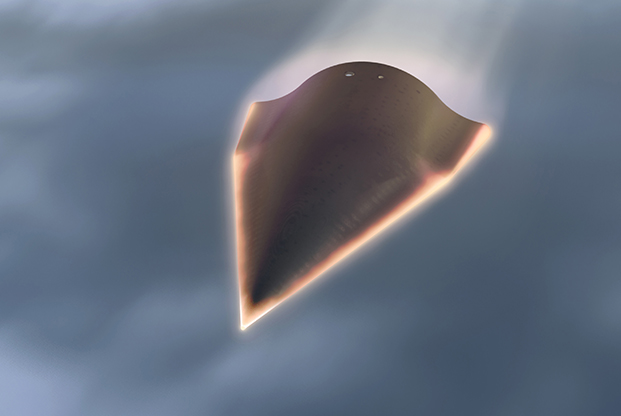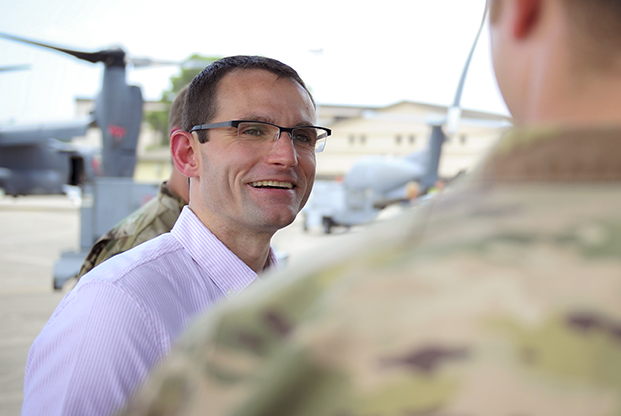
USAF’s heightened focus on speed is making long-duration hypersonic flight a reality. This artist’s rendering shows Darpa’s HTV-2, a prototype reusable, rapid-strike weapon system, re-entering the atmosphere. Illustration: DARPA
The Air Force could have its first hypersonic weapon within two years, demonstrating a faster acquisition and development process the Air Force hopes will accelerate its modernization push on many levels.
Speed—both hypersonics and faster technology and program development—were core to the messages Air Force leaders took to the force during AFA’s Air, Space & Cyber Conference in September.
The development strategy for Next Generation Air Dominance (NGAD) will emphasize prototyping and experimentation rather than rapidly becoming a large-scale program of record, they reported.
To accelerate innovation, Air Force Acquistion chief William Roper said, the Air Force is also focusing on finding better ways to maintain and sustain its platforms, forming a Rapid Sustainment Office modeled on the service’s Rapid Capabilities Office, which aims to rush new technologies into use. The new organization will apply predictive analytics and other advanced technologies to the nuts and bolts work of keeping systems operational. Sustainment has long taken a back seat to new combat technologies in the competition for headlines, but sustainment is “where 70 percent of our budget is,” Roper said.
The potential for savings is significant. Roper said the new office will “pay for itself” and will be disbanded after two years if it doesn’t; an unlikely scenario, he said.

TSgt. Jordon Jones (left), SSgt. Charles White, and SrA. Jaceb Brammer (right) inspect an F-16 at Misawa AB, Japan. USAF is seeking better ways to maintain and sustain its platforms. Photo: A1C Collette Brooks
Deputy Defense Secretary Patrick M. Shanahan, in a keynote address at the conference, said the commercial aircraft industry is far ahead of the US military in understanding aircraft sustainment and wringing savings out of it.
The military should be “humble” and learn from “those who do it well.” Shanahan said the military should “rip off and deploy the tools and systems” aircraft maintainers need to get the job done faster and at less cost.
According to Roper, the Hypersonic Conventional Strike Weapon (HCSW, pronounced “Hacksaw”) could be operational as soon as December 2020. It’s “a fact that we can compress the development into two years,” he said, although admitting that dates could slip because of the need to “test aggressively.”
The HCSW will then follow a “spiral development” plan, Roper said.
“You’ll go into some low rate of production, then keep spiraling the technology until you get enough bells and whistles on the weapon and you say, ‘That’s the one I want to buy,’?” he explained. Too many programs have faltered in the past because the service attempted to reach the objective capability in the initial version. That resulting “concurrent risk” slowed development and jacked up cost.
“We’re trying not to do this” with hypersonics, Roper said.
The HCSW is only one of at least four hypersonic projects USAF is pursuing, including boost-glide munitions and air-breathing missiles with longer range and maneuverability.
Among the US Armed Forces, the Air Force is “out of the starting gates the fastest” on hypersonics and will likely be the first to have an operational weapon, Roper said. The services are working together though. Air Force Secretary Heather Wilson said cooperation with the Army and Navy has already “saved 10 years” of development effort. The services are sharing effort on overlapping technologies, while leaving each free to concentrate on their unique launch requirements.
They have agreed “to use the best technology, no matter where it comes from; go fast, share results, and build harmony,” Wilson said.
Roper said the HCSW and test models from the other services would likely be test-launched from B-52s.

William Roper, assistant secretary of the Air Force for acquisition, technology, and logistics, said USAF is out front on developing hypersonics and all the services are working together to bring the capability to fruition. Photo: A1C Isaac Guest IV
Roper came to his USAF acquisition post from the Pentagon’s Strategic Capabilities Office (SCO), where he was the founding director, and the Air Force’s HCSW flows from work done there. Making use of that body of work has allowed the hypersonics effort to be accelerated, he told reporters, saying he’s handed the program off to himself in his new job.
Roper also said the USAF management team has set a goal to take “a hundred years” out of acquisition programs—and has already cut 56 years from program schedules. “I think we’ll make it,” he said of the 100-year objective. It’s happening “much faster than I was expecting.”
By focusing only on “the things that really matter” and on the 90 percent solution, rather than perfection, programs can move forward much more quickly.
But Roper is still aiming to cut the time to issue contracts. “Two months is not fast enough” for deals, he said. He’d like to complete simple negotiations and agreements in “a single day.” Doing so is especially important with startup companies working on innovative new concepts; they don’t have the cash to wait months for the government to issue a contract. Procedures that would require only short, one- or two-page proposals, a video pitch, and then a live pitch could ultimately result in on-the-spot contract offers.
Even if those startups don’t survive, or are bought up by bigger companies, the people there will have been exposed to the Air Force and its needs, and that will likely pay dividends later, he said.
To keep things on track, Roper said all programs will be given a time limit, and if program managers want even “an extra day, week, or month” they’ll have to “fight for it.” Industry embraces this approach and already has the mindset that “we have to make this quarter count; we have to make this year count.”
The bottom line, Roper said, is: The US military will win the technology battle with its peer competitors, “as long as [we] don’t get in our own way.”
Nonetheless, Roper said he’s encouraging program managers to take risks.
The Air Force must be “willing to fail” as it experiments with new ideas—however it must not accept failure on major projects like the Ground Based Strategic Deterrent nuclear missile, which will require decades of sustainment and will benefit from taking extra time “at the front end” to reduce risk and cost later.
The Air Force has acknowledged that it needs to up its game in air superiority if it is to remain dominant in the 2030 time frame, which means investing in new capabilities now. Roper said the NGAD can “learn from the SCO approach, which is, you should start with what you have.”

An F-35 test aircraft releases a missile during a live-fire test over the Gulf of Mexico. USAF is pursuing a goal to speed up acquisition. Photo: MSgt. Michael Jackson
Lt. Gen. Arnold W. Bunch Jr., the Air Force’s top uniformed acquisition leader, told reporters “we need to invest in multiple areas of technology” to map out the NGAD strategy.
“It was not set aside that it was going to be a specific answer,” he noted, but likely a combination of platforms, technologies, and networking. Areas of experiment will include “how we [do] data decision, how we do defeating agile, intelligent targets,” and the results will help determine “what we may be able to invest in” with regard to new products as well as the upgrade of older systems.
“We are looking at advancing key technologies that I won’t go into,” Bunch said. “We’ve got money laid in” for experiments and prototyping. The results of those will drive investments, he said.
Roper noted the Air Force wants a “balance between these polar extremes … which is exquisite capability on platforms versus a system of systems. … The answer isn’t one or the other, we want the best of both.”
This portfolio approach will not be a “traditional, top-down acquisition process,” he said, which “has not worked well for highly tech-driven programs.” The aim will be to continue to limit time lines and press ahead with the technologies that mature within that time line. Roper said USAF will be “very mindful that when you’re trying to target multiple technologies, probably not all of them are going to succeed.”
Air Force officials say the main NGAD technologies are likely to include: extremely low observability aircraft; directed-energy weapons; small, long-range multi-sensor munitions; new variable-cycle longer-range/higher-thrust engines; and augmented and artificial intelligence systems.
Bunch and Roper said they will have a role in moving the Air Force toward a capacity of 386 wings, if that level is approved by Congress and funded, but will chiefly take the job of seeing how existing and future production lines can be adjusted efficiently.
“It’ll be our job to present the best acquisition approach, and that will mean us going through production lines, and [asking], ‘can we go up or down? How can we change within current contracts that we have?’?” Roper explained. “We will really have to do the rubber hitting the road … when we understand what budget to target.”